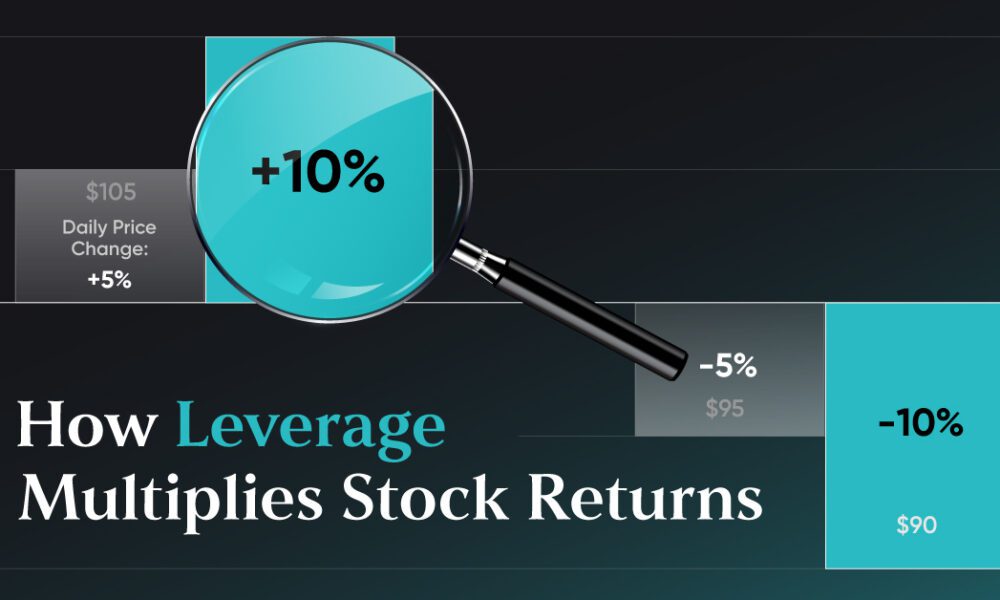
Key Takeaways:
The Power of Leverage: Maximizing Your Stock Returns
When it comes to investing in the stock market, every investor dreams of unlocking ultimate returns. The question then becomes: What strategies can help us achieve this seemingly elusive goal? One powerful tool that can significantly enhance your stock returns is leverage.
The Basics of Leverage
Before diving into the intricacies of how leverage can help you unlock the ultimate stock returns, let’s first define what leverage actually means. In the realm of investing, leverage refers to the use of borrowed capital to amplify the potential returns of an investment.
Imagine this – You have $10,000 to invest in a particular stock and you believe it is poised to perform exceptionally well. Instead of investing the entire $10,000 on your own, you choose to use leverage by borrowing an additional $40,000 from your brokerage firm. This brings your total investment to $50,000.
Let’s assume that the stock you invested in generates a return of 20% in a year. If you had only invested your $10,000 without leverage, your profit would have been $2,000. However, thanks to your $40,000 borrowed capital, your profit is amplified to $10,000. This means that with leverage, your return on investment doubles to a staggering 100%!
The Pros and Cons of Leverage
While leverage can undoubtedly enhance the potential gains of your stock investments, it’s essential to understand both sides of the coin. Here are some notable pros and cons of utilizing leverage:
Pros:
- Increased Profit Potential: As we saw earlier in the example, leverage can greatly amplify the gains on your investments. It allows you to maximize your profits by utilizing borrowed funds.
- Diversification Opportunities: Leverage provides you with the ability to diversify your portfolio more extensively. With a smaller initial investment, you can effectively spread your funds across different stocks, sectors, or even markets.
- Liquidity Flexibility: By using leverage, your capital is not tied up in a single investment. This liquidity flexibility enables you to take advantage of emerging investment opportunities or quickly adapt to changing market conditions.
Cons:
- Increased Risk: Just as leverage can amplify gains, it can also magnify losses. The borrowed capital requires repayment, even if your investments suffer a decline. It’s crucial to carefully manage risk and have a firm grasp of the potential downsides.
- Interest Costs: Leverage is not free. Borrowing capital from your brokerage firm comes with interest costs. These costs can eat into your overall returns and should be taken into consideration when calculating potential profits.
- Margin Calls: Margin calls can be a huge challenge when utilizing leverage. If the value of your investments drops significantly, your brokerage firm may require you to deposit additional funds to meet the margin requirements. Failure to do so could result in forced position liquidation.
Risk Management: The Key to Successful Leveraged Investing
Leverage can undoubtedly be a powerful tool in the world of stock investing. However, it’s crucial to exercise caution and implement effective risk management strategies. Here are a few key principles to help you navigate the world of leveraged investments:
1. Diligent Research and Analysis:
Before utilizing leverage, it is essential to conduct thorough research and analysis on your chosen investment. Understanding the company’s financials, industry trends, and market dynamics can help you make informed decisions and mitigate potential risks.
2. Proper Asset Allocation:
When incorporating leverage into your investment strategy, diversification becomes even more critical. Spreading your borrowed capital across multiple assets and sectors can reduce the risk of significant losses in case of adverse market conditions.
3. Set Realistic Stop-Loss Orders:
Stop-loss orders are an excellent way to protect your leveraged investments from significant downturns. By setting predefined exit points, you can limit your losses and minimize the impact of adverse market movements.
4. Constant Monitoring and Adjustments:
The stock market is continuously evolving. It’s essential to regularly monitor your investments and make necessary adjustments. This could include taking profits, reducing exposure to certain assets, or cutting losses when appropriate.
5. Professional Guidance:
Seeking advice from qualified financial professionals can be invaluable when dealing with leveraged investments. They have in-depth knowledge of the stock market and can guide you in your decision-making process, ensuring you understand the risks involved.
Frequently Asked Questions
In Conclusion
Unlocking the ultimate stock returns requires a deep understanding of the power of leverage and its potential impact on your investments. When used correctly and alongside effective risk management strategies, leverage can be a valuable tool in your investment toolbox. However, it’s important to remember that leverage amplifies both gains and losses, so it must be approached with caution and a clear understanding of the risks involved. Research, diligence, and professional guidance can help you unlock the full potential of leverage and maximize your stock returns.
Source: insightfullgo.com

